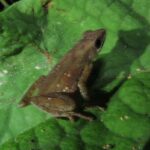- Uncovering the Secrets of the Uluguru Forest Frog: Probreviceps uluguruensis
- Taxonomy and Classification
- Natural Habitat: The Misty Realm of the Uluguru Mountains
- Distinctive Physical Characteristics
- Behavior and Life Cycle: Quiet Champions of the Leaf Litter
- Ecological Role: Guardians of the Forest Ecosystem
- Threats and Conservation: A Fragile Existence in Changing Times
- Cultural and Scientific Significance
- Conclusion: Protecting a Hidden Treasure
Uncovering the Secrets of the Uluguru Forest Frog: Probreviceps uluguruensis#
Amidst the lush, misty mountainsides of Tanzania’s Uluguru Mountains, nestled discreetly within deep leaf litter and moss-covered forest floors, lives an incredible creature whose elusive nature rivals its captivating appearance—Probreviceps uluguruensis.
Commonly known as the Uluguru forest frog, this diminutive amphibian has adapted masterfully to its life among dense vegetation and soggy soils of the Eastern Arc Mountains. Though small in size, it manages to intrigue biologists, environmentalists, and nature lovers alike, drawing them into the rich mysteries embedded within Tanzania’s unique habitats. One fascinating trait immediately sets this frog apart: unlike the stereotypical jumping frogs we often envision leaping gracefully beside ponds, Probreviceps uluguruensis moves mostly by crawling, rarely venturing far from its leaf-covered sanctuary.
In a rapidly changing natural world, amphibians have become key indicators of ecological health, and Probreviceps uluguruensis offers vital insights into ecosystem balance, environmental quality, and biodiversity in East Africa. Join us on a narrative-driven journey into the lush montane forests to uncover the secrets of this unique Tanzanian amphibian and unravel the layers of its life history, behavior, ecological significance, and pressing conservation challenges.
Taxonomy and Classification#
To fully appreciate Probreviceps uluguruensis, we first need to explore its taxonomic background. This remarkable species belongs to the family Brevicipitidae, a group of frogs collectively known as rain frogs or short-headed frogs. Members of Brevicipitidae are characterized by their stout bodies, short limbs, and round eyes that peer curiously from beneath thick folds of skin—a true hallmark of their ground-dwelling adaptations.
The genus name “Probreviceps” itself hints at these unique physical characteristics, echoing the frog’s squat, robust body shape. The species epithet, “uluguruensis,” directly references its geographical home: the remote and biodiverse Uluguru Mountains of Tanzania. First described scientifically by Barbour and Loveridge in 1928, the species’s classification has remained stable, contributing significantly to our understanding of montane biodiversity and evolution in East Africa’s amphibian fauna.
Natural Habitat: The Misty Realm of the Uluguru Mountains#
To find the Uluguru forest frog, one must venture deep into Tanzania’s Eastern Arc—a remarkable chain of ancient mountains known for their rich biodiversity and high degree of endemism. Within this region, Probreviceps uluguruensis is endemic to the Uluguru Mountains, making this species an exclusive resident of this single, highly specialized habitat.
Precise Locations and Habitat Preferences#
More specifically, this frog resides in montane and sub-montane forest floors at elevations typically ranging from about 600 to 2,400 meters above sea level. The habitat is one of perpetual moisture, characterized by dense canopies, persistent mists, frequent rainfall, and richly organic leaf litter. Beneath towering trees like Podocarpus and African mahogany, with dense understory vegetation including ferns and mosses, the frog makes its living in secret, accessible perhaps only to determined naturalists or coincidental visitors.
An Amphibian Perfectly Adapted to the Montane Environment#
This habitat does more than simply shelter the frog—it directly shapes their adaptations and behaviors. Probreviceps uluguruensis rarely, if ever, climbs or ventures outside damp leaf litter and humus-rich layers on the forest floor. Its lifestyle is entirely associated with moisture-retention and temperature stability present within leaf litter that acts as a protective blanket, sheltering the frog from predators, climatic extremes, and dehydration.
Distinctive Physical Characteristics#
Probreviceps uluguruensis certainly presents a highly adapted set of physical characteristics. Measuring a petite 20–35 mm in length, this frog seems sturdily built, its plump rounded body sustained by short limbs that distinctly limit terrestrial movements to a crawling gait rather than the energetic leaps or jumps we typically associate with frogs.
Beautiful Camouflage Patterns of the Forest Floor#
The species’ coloration and body texture blend effortlessly into their surroundings, an elegant evolutionary solution to evade predation. Their skin is comparably rough, mottled in tones of russet brown, deep ochre, and subdued olive-green hues befitting the leaf-littered forest habitats. Patterns of subtle bands and speckling across their backs add an additional camouflage layer, rendering them virtually invisible among the moist decaying vegetation.
Adaptations for Moisture Retention and Survival#
The frog employs a suite of unusual adaptations for moisture retention. Thick, sometimes granular skin aids with water conservation amidst periods of lower rainfall. Their squat, rounded shapes also ensure minimum surface-area-to-volume ratio, reducing moisture loss. In essence, every physical feature of Probreviceps uluguruensis exemplifies a successful evolutionary response to their microhabitat specialization.
Behavior and Life Cycle: Quiet Champions of the Leaf Litter#
Though discreet, the Uluguru forest frog provides vital services in their ecosystem through their ecological behaviors and life cycles.
Diet and Feeding Habits: Insectivorous Diet of an Amphibian Predator#
The diet of Probreviceps uluguruensis largely comprises small terrestrial invertebrates, and they’re adept ambush predators who stealthily seize prey moving through the leaf litter or forest humus. They feast primarily on ants, mites, termites, and small beetles, providing important pest control services within their ecosystem.
Unique Breeding and Parental Care Behaviors#
Mating habits are also fascinatingly adapted to their montane forest floor dwellings. Unlike many frogs, Probreviceps uluguruensis does not breed in water or lay aquatic eggs. Instead, breeding occurs directly within moist subterranean chambers or leaf litter. Females produce relatively few, comparatively large eggs enveloped by dense protective jelly, and rather astonishingly, this species exhibits parental care, with mothers carefully guarding their eggs. Eggs hatch directly into miniature froglets, bypassing the free-swimming tadpole stage—a brilliant solution for amphibians living far from permanent water bodies.
Ecological Role: Guardians of the Forest Ecosystem#
The Uluguru forest frog acts as a veritable cornerstone of its ecosystem, shaping food chains and indirectly benefiting numerous other species. Their predatory habits control populations of small invertebrates, maintaining ecological balance. Conversely, they serve as prey for various larger forest predators, including birds, small mammals, and forest-floor dwelling reptiles, tightly interwoven within their complex montane ecosystem.
Crucially, amphibians like Probreviceps uluguruensis are also sensitive indicators of environmental stressors. Their porous skin and close dependence on microclimate conditions make them among the earliest alarm bells indicating changes in climate or habitat disturbance.
Threats and Conservation: A Fragile Existence in Changing Times#
Despite their remarkable adaptations, the survival of Probreviceps uluguruensis faces increasing pressures. Habitat fragmentation, deforestation for agriculture, climate change disturbance, and invasive species threaten their fragile environments, and mortality often results from subtle shifts in temperature, moisture, or pathogen exposure.
IUCN Status and Conservation Initiatives#
The International Union for Conservation of Nature (IUCN) currently classifies Probreviceps uluguruensis as Near Threatened. This means awareness and conservation actions are essential priorities. Organizations have initiated forest protection measures within the Uluguru Mountains, promoting community-based conservation programs, ecotourism, responsible agriculture, scientific monitoring, and education about the importance of biodiversity.
Cultural and Scientific Significance#
This frog is emblematic of Tanzania’s biodiversity heritage, yet cultural recognition remains limited due largely to its hidden nature and restricted habitat range. Scientifically, however, it symbolizes critical areas of research, evolution studies, climate change indicator monitoring, and ecosystem dynamics—all vital fields of biological and conservation work.
Conclusion: Protecting a Hidden Treasure#
Probreviceps uluguruensis embodies the wonders and critical nature of biodiversity in exceptional forest habitats like the Uluguru Mountains. Yet, despite its unique adaptations and ecological importance, it remains precariously perched between conservation optimism and vulnerability to continuing threats. Protecting this amphibian means protecting the intricate, life-sustaining forests they rely on, calling for increased awareness, dedicated research, and steadfast conservation efforts. By choosing awareness, appreciation, and action, we secure not merely the survival of this humble frog, but the future of Tanzania’s most precious natural heritage.







